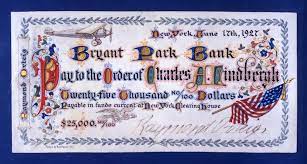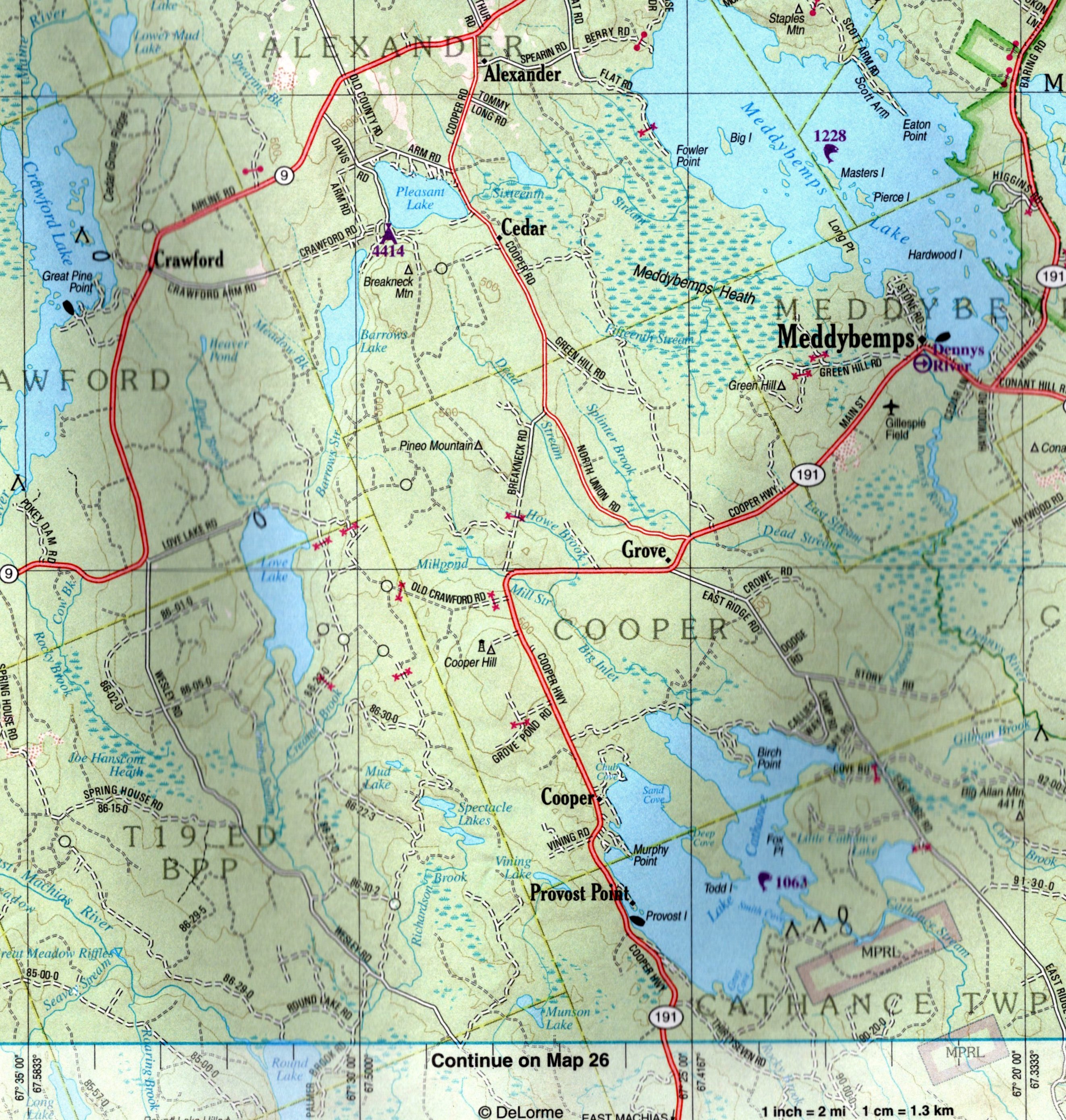
Township 19 ED and Cooper Round Lake bottom left
A few miles to the south of Love Lake which is partly in Crawford but mainly in Township 19 ED there is a small, rather nondescript lake called Round Lake. On the map above it is at the bottom left and is accessible from the Airline via the Wesley Road in Crawford. Probably only a handful of readers have ever been to Round Lake but there were times in the 1980 and 1990’s when hundreds of searchers, equipped with expensive high tech metal detectors and sonar gear spent tens and perhaps hundreds of thousand of dollars searching for a missing airplane. There was no urgency-the plane had been missing for 60 years and no one had actually seen it crash near Round Lake.
In fact, no one had actually seen the plane since May 8, 1927, when according to a young boy from Ireland, he and his father saw the plane with its distinctive markings “flying fairly high over the River Shannon and went west over Knocknagaroon Hill towards the Atlantic.”
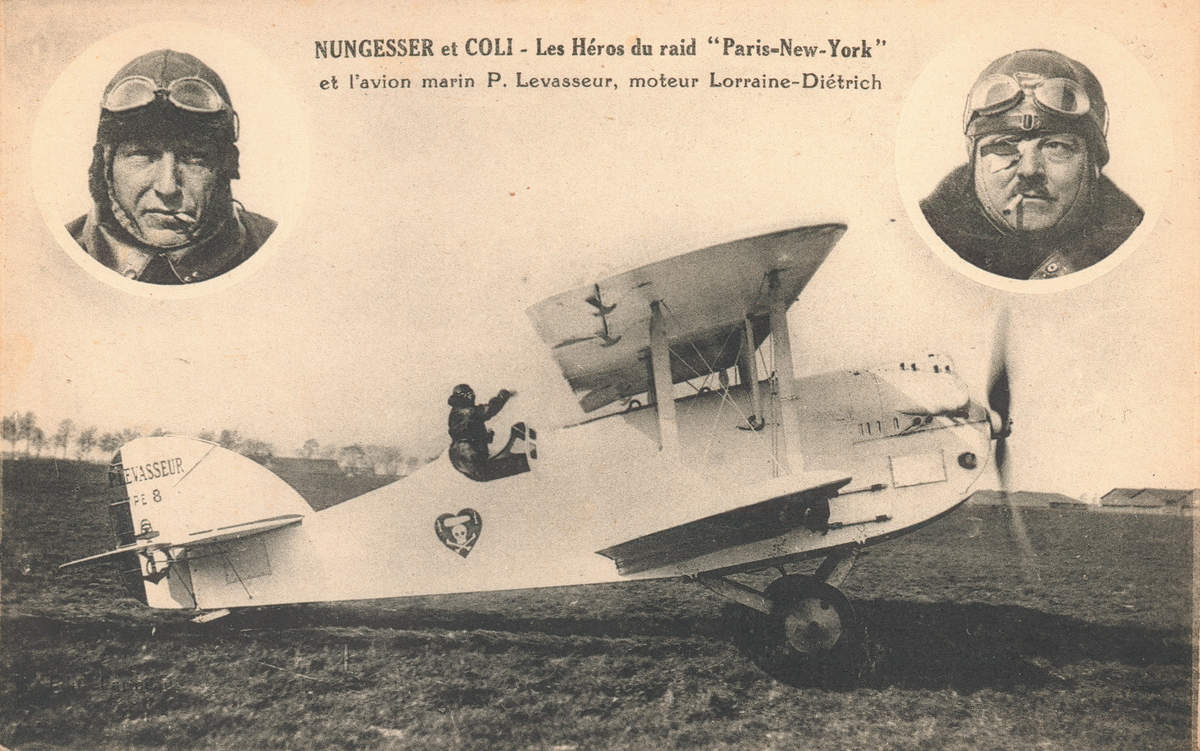
The White Bird Nungesser and Coli
The plane was the L’Oiseau Blanc, the White Bird. Two men were on board, Charles Nungesser, the pilot and Francois Coli, the navigator. They were Frenchmen, both were aviator heroes of the First World War-Nungesser a daredevil ace with 45 enemy planes to his credit and Coli a navigator who had lost an eye in a plane crash during the war. A partial list of Nungesser’s war wounds reads as follows: Skull fracture, brain concussion, multiple internal injuries, five fractures of the upper jaw, two of lower jaw, shrapnel imbedded in nearly every part of his body, bullet wound in mouth and ear, dislocated wrist, ankle, clavicle…

Raymond Orteig was a French American Hotel Owner
The point is they were brave, a bit mad and had every intention of winning the Orteig prize of $25000 for completing the first non-stop flight across the Atlantic between Paris and New York. When the prize was first offered in 1919 there was no plane even capable of the flight. However, when reissued by Orteig in 1925, airplane technology had improved dramatically and not a few aviators had died trying to win the prize. There had been flights from Ireland to Newfoundland but in 1927 a cross Atlantic flight from Europe to the East Coast of the United States was at the outer limits of aircraft technology. Even a slight navigational error, a miscalculation of fuel consumption or a sudden change in the weather meant almost certain death in the icy Atlantic.
Still when Nungesser and Coli took off from Le Bourget Airfield in Paris on May 8, 1927, there were several planes in New York making final preparations for the attempt.
From the Meriden Connecticut Journal May 9, 1927:
“WHITE BIRD’S” HOP-OFF CLIMAX OF KEEN RIVALRY
Five Expeditions Hoped to Be First to Make Trip New York May 9 (AP)—
The hop off of the “White Bird” biplane of Captains Charles Nungesser and Francis Coll from Paris to New York climaxed months of keen rivalry among five expeditions for the honor of being the first to make a non-stop flight between France and America. Four expeditions had been formed in this country to make the trans-Atlantic flight which Captain Rene Fonck, French war ace attempted last year but whose attempt ended in tragedy. The American entry nearest to taking off is the Bellanca monoplane which recently established a new world’s record for sustained flight of more than 51 hours. Lloyd W Beraud as navigator and Clarence Chamberlin as pilot had expected to take off early this week but sponsors of the proposed flight announced last night the flight would be delayed until the result of the Nungesser attempt is known and if successful the Bellanca plane would substitute some other long non-stop flight.
In place of the Paris hop another expedition that is nearing completion for a takeoff is that of Captain Winston W. Ehrgott air mail pilot which is being formed in St Louis. This plane was expected to take off shortly for New York as a final step in its trans-Atlantic flight. Accidents wrecked the plans of two other proposed expeditions The “American Legion” plane in which Commander Noel Davis of the U S Navy hoped to make the trip was wrecked in Virginia and Davis and his pilot Lieutenant Stanton H Wooster were killed. The American plane of Commander Richard E Byrd of the U S Navy also figured in an accident which badly disrupted the expedition plans. Byrd suffered a fractured wrist, and his pilot Floyd Bennett was seriously Injured. The plane was slightly damaged. Captain Fonck who was the first to actually take off in a New York-to Paris flight also is in this country preparing for a second attempt which however he does not expect to make before late summer. In his first attempt from Mitchell field last year the plane crashed shortly after its take-off and two of his crew were killed.
Surprisingly the plane of a young flyer named Charles Lindbergh was not one of those waiting in New York to chance the Atlantic. He was relatively unknown and making his plans in St. Louis. None of the many East Coast reports of prize contestants even mentioned his name.
At 5:17 local time Nungesser and Coli departed from Le Bourget. An east-west flight across the Atlantic was far more difficult than a crossing from west to east due to the prevailing winds. To lighten the plane, they jettisoned the landing gear intending a belly landing in New York harbor and took no food except a few bananas, coffee in a thermos and caviar. They expected to be in the air for 36 hours.
How long they were in the air is one of the most confounding aeronautic mysteries of the ages. The young boy on the hill in Ireland saw the White Bird several hours after takeoff. No one except Harold Vining of Cooper and Evelyn Magoon of Crawford has claimed to have seen it after it passed over Knocknagaroon Hill in Ireland although many have claimed to have heard it. The weather over the Atlantic closed in soon after the White Bird took off and much of their entire flight, however long or short it may have been, was in nearly zero visibility. Did the French plane actually get across the Atlantic to North America? There was evidence they did although none of the reports was confirmed. Typical of reports from Newfoundland of hearing the plane overhead in the thick fog is one from the Philadelphia Enquirer:
Men Living 65 Miles From St. Johns, Newfoundland, Tell of Hearing Airplane on Monday Morning
Meanwhile Navy Ships and Liners Continue Search in Atlantic
Dirigible Los Angeles Joins Hunt Today A definite report was received from Newfoundland today, two men living in Harbor Grace Sixty-Five miles north of St. John’s, heard an airplane passing inland in the fog between nine and ten O’clock Eastern standard time, Monday morning. Patrick O’Brien and Captain John Stapleton today informed Newfoundland officials that though they could hear the motor for almost twenty minutes, they were no able to see the plane. This report dovetails with the report sent out last Monday morning from St. Pierre Miquelon where an airplane was heard similarly in the fog. O’Brien was working in his field about a mile from Harbor Grace when he heard the airplane. His reason for failing to report the incident before, it was learned was that he knew nothing about the ocean flight until he heard friends talking about it early this morning. The Canadian Air Force at Ottawa declared that no Canadian aircraft had been flying in the vicinity or Newfoundland this week.
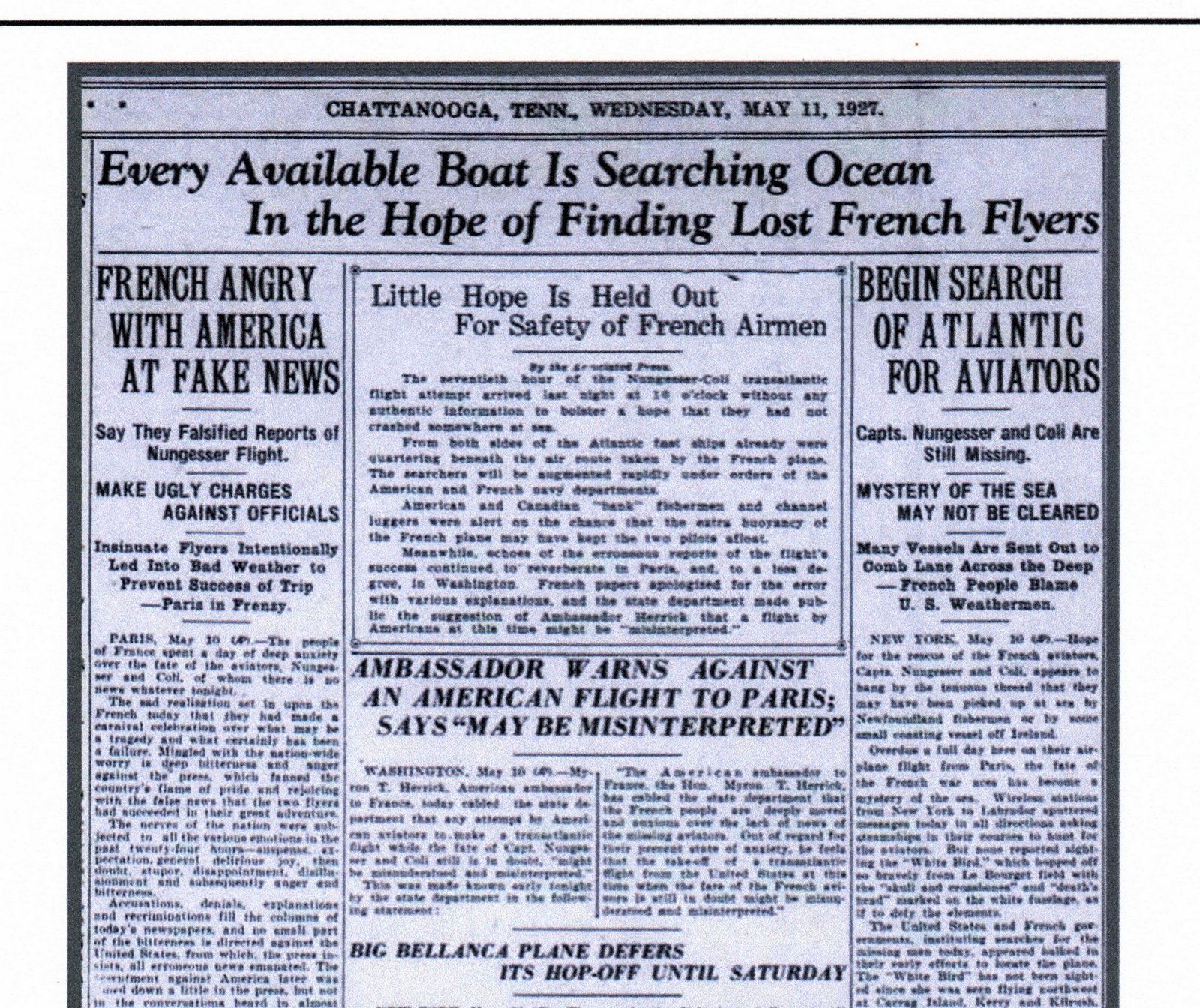
The French naturally became concerned at the lack of verified sightings of the White Bird but were ecstatic after several U.S. news reports circulated claiming that the plane had been seen proceeding along the Atlantic Coast on course on Monday and only hours from landing in New York. These reports later turned out to be false but France were wild with excitement, celebrations went into the night but when Parisians awoke the next morning, they discovered their heroes were missing and the plane presumed lost.
Over the next month search parties were sent to Newfoundland, funded by Filene’s of Boston and to other locations based on questionable reports of locals. A hoax in June was particularly cruel. The day a memorial was being dedicated to the French flyers in France an accountant for a Quebec lumber company called from the north woods to report he had seen flares and investigating had found the two flyers alive. This news was reported at the dedication in France. The man soon confessed he had made the false claim “Just to relieve the monotony.”

Within two weeks of the disappearance of the White Bird Charles Lindbergh had taken off from New York and landed at the airport in Paris from which the White Bird had begun its fatal flight. After being mobbed by jubilant French citizens Lindbergh insisted on visiting Nungesser’s mother, an act which endeared him to the French and the world.
Orteig was as good as his word
The mystery of the White Bird lay dormant for nearly 50 years although there were many rumors and unconfirmed reports at the time of plane’s disappearance which suggested the plane had not only crossed the Atlantic successfully but had flown as far as Maine. Later these rumors began to focus specifically on Eastern Maine and even more specifically on the vicinity of Round Lake in Township 19 Middle Division.
The eminent local historian John Dudley in a short history of Township 19 ED wrote:
1927 White Bird Crashed here or nearby.
1927 on May 27 a biplane took off from Paris’s LeBourget Airport on an attempt to fly across the Atlantic to New York. Francois Coli and Charles Nungesser were aboard and hoped the first to cross the ocean and collect the $25,000 prize. The plane that weighed 11,000 pounds, was 32 feet long with wings of nearly 48 feet. Its engine was a 450 horsepower, 12-cyclinder Lorraine Dietrich. All “Vanished like a Midnight Ghost” according to Lucky Lindbergh. Some believe that the White Bird crashed near Round Lake in Township 19, ED BPP.
He notes the recollections of Evelyn Magoon:
Evelyn Magoon and her parents lived on the Lydic Set-off in Crawford. That property was once in Alexander but since April 2, 1859, has been in Crawford and bounded on three sides by Alexander. Evelyn remembered that day in 1927 when the airplane circled her house twice in unsettled weather before heading toward Love Lake. Evelyn [1917 – 2004] married Philip Sharpe and was living in Augusta when she told her memories.
Interest in the fate of White Bird and its crew revived about 1980 when Gunnar Hansen of Northeast Harbor and a group of searchers began combing the hills near Round Lake for the missing aircraft. According to an article he wrote in 1981:
They were drawn to this area by several clues, the most important being provided by Anson Berry, a Washington County man who was fishing in his canoe on Round Lake the afternoon of May 9, 1927. The weather had been bad all that day – a low overcast with fog. And now the weather was getting worse. A storm was brewing, and Anson Berry wanted to be off the lake and back at his camp four miles downstream on Wigwam Rips before it broke.
As he paddled back, the silence was broken by what sounded to him like an airplane engine running erratically. Though he could not see it because of the fog and heavy overcast, he estimated that it passed overhead at about a thousand feet. Immediately afterwards the engine stopped, and he heard a faint crash, as if the airplane were ripping through the tops of trees.
Then the silence of the lake returned. He did not investigate what he had heard, probably because of the worsening weather, and because he wasn’t quite sure of what he had heard. Perhaps he thought that, if he did go look, darkness would overtake him before he could return to his camp. It is also possible, as an acquaintance of his has suggested, that Berry just didn’t think it was any of his business. He was not one to stick his nose into other people’s business.
Whatever the reason, he did not investigate. And, of course, he did not know anything· about what had been going on in the U.S. and Europe during the past months. He had no radio and came into town only about once a month.
The next day, when he walked to the nearby village of Northfield for supplies, he did not mention the accident. While in Doten’ s store he even picked up a newspaper and read the front-page headlines declaring two French aviators missing after having left Paris two days before to attempt the first east to-west transatlantic flight in history. Still, he said nothing.
It was only years later that he spoke up, and by then interest in the missing Frenchmen had dwindled, obscured by the successful flight of Charles Lindbergh from New York to Paris twelve days after they had taken off and disappeared.
The Berry story, as incredible as it may seem, became the subject of an article by Herb Cleaves in the Bangor Daily which seems to have piqued the interest of numerous national groups and celebrities who specialized in solving mysterious disappearances.
The primary group involved in the search was TIGHAR-The International Group for Historic Aircraft Research led by Richard Gillespie of Pennsylvania. The group organized several expeditions in search of the plane including one documented by Herb Cleaves of the Bangor Daily in 1984:
Volunteers briefed on search for lost biplane By Herb Cleaves NEWS Machias Bureau — MACHIAS —
A search for the remains of a French airplane that might have made the first non-stop trans-Atlantic flight from east to west 57 years ago was set in motion late Friday at Machias. With the blessing of the government of France and the youngest daughter of a daring French aviator who was the navigator of L’Oiseau Blanc (The White Bird) on its ill-fated flight of May 8, 1927.
Richard E Gillespie of Bensalem Pa outlined techniques to be used Saturday and Sunday to find evidence that the plane crashed in a remote section of eastern Maine northeast of Machias. Several searchers were expected to brave inclement weather not unlike that encountered by Capts. Charles Nungesser and Francois Coli to comb an area near Round Lake east of Wesley where Gillespie theorized that the French plane went down.
“Our feeling is that they did indeed cross the Atlantic successfully and went down somewhere in eastern Maine” said Gillespie during a presentation to the group of about 25 people assembled for the search Gillespie said Nungesser and Coli were two of the world’s best-known aviators in 1927 and their venture was not one taken lightly “Their take-off at LeBourget airfield (in Paris) marked the first time an aircraft with enough fuel to get it across the ocean actually got off the ground” he said.
Gillespie said Coli was asked why the French aviators did not go to New York and attempt the trans-Atlantic crossing the easy way with the prevailing winds from West to East. Coli’s response was “If we did that it would appear that we were coming to visit ourselves” he said. Gillespie described the weather and suggested that the flyers had “come through a terrible night” by the time they reached the coast of Newfoundland where 16 positive sightings were reported. There he said the weather improved so it was likely the aviators pressed on to try to reach a destination in the eastern United States. Using maps, the search party ‘s leader suggested that the plane ran out of fuel somewhere near Round Lake north of Machias. Gillespie said a letter from Coli’s granddaughter written on behalf of her mother expressed support. The letter he said gave the searchers “something of a sense of responsibility to the family”. The search was expected to start about 7 a m Saturday.
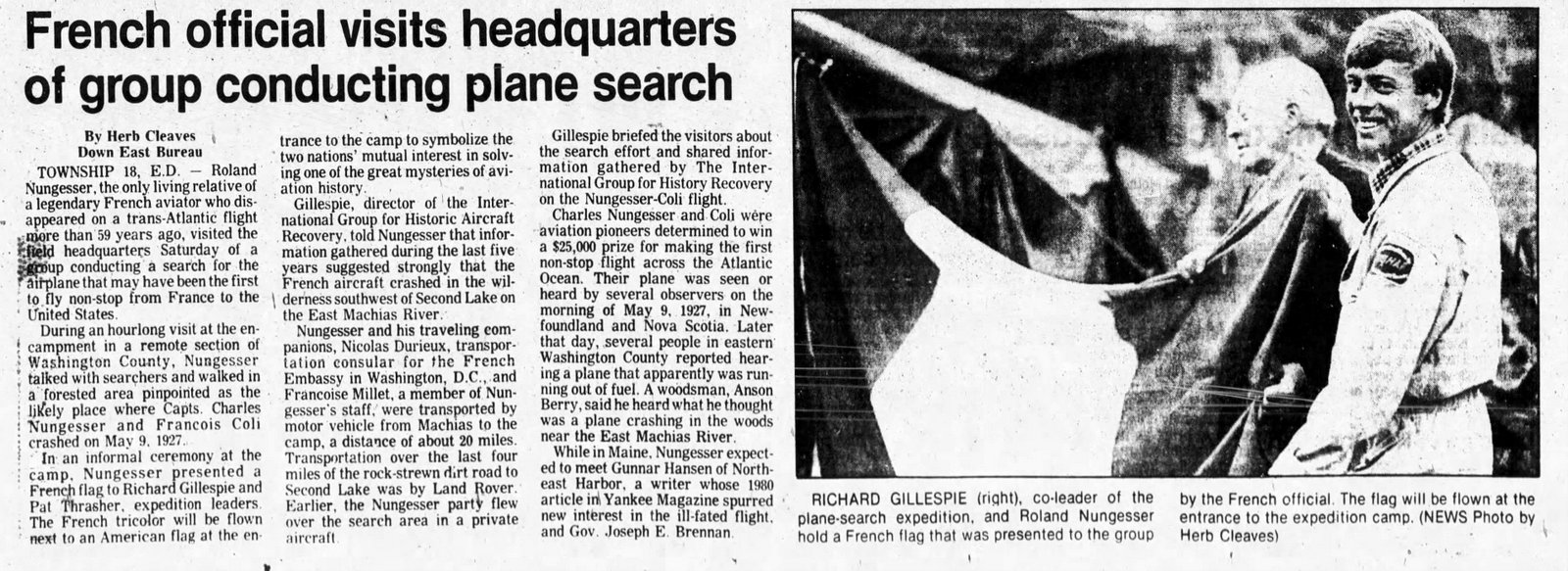
Bangor Daily News 1986. One a Nungesser Nephews was in the search party in 1986
Two years later he had convinced French authorities that he had solid evidence TIGHAR was on the right track and the French government even reopened their 1927 investigation which had concluded the plane had crashed into the Atlantic before reaching Newfoundland. Again, nothing was found and the search may have been abandoned entirely had not Harold Vining of Cooper come forward with his memory of that fateful day in 1927.

Bangor Daily News
Wednesday May 6, 1987
COOPER NATIVE Harold Vining 78 stands on the front doorstep of the Vining family’s homestead pointing his finger toward Machias and the direction that he heard an airplane flying May 9, 1927. In his opinion he heard the French biplane White Bird one minute before it crashed (NEWS Photo by Clayton Beal)
Cooper man claims he saw White Bird on night it crashed
By Clayton Beal Down East Bureau
COOPER — Harold Vining is one of the few Mainers who encouraged members of the International Group for Historic Aircraft TIGHAR to continue their search at Machias again this year for the missing 1827 vintage French biplane the White Bird. Vining is one of two witnesses who believe that the area west of Second lake in Township 18 Eastern District is the spot where the white plane might have exhausted its more than 1000 gallons of fuel and crashed.
The other witness Jim Reed of Vinalhaven didn’t track the plane by sight or sound but he claims to have actually seen the biplane’s engine one day in 1970 while he was deer hunting in the Second Lake area. Reed’s testimony is of special interest because he is a former mechanic for the US Air Force and Pan American Airlines
Reed didn’t spend a lot of time inspecting the engine for details concerning its design, proof of manufacturer and evidence that might have indicated that the engine fell out of the sky. When he was shown a photograph of the biplane’s engine, he identified the engine by pointing to the trumpet-shaped ram-air intake He said that the motor he saw was partly covered by gravel and debris. Vining’s testimony on the other hand is that he not only heard an airplane engine pass over his parent’s house 60 years ago but that he also heard that engine stop suddenly “It was like you turned it off like a switch” he said. Earlier this spring his simple but convincing testimony inspired TIGHAR’s leaders to shift the focus of the search to the area between Second Lake and the East Machias River.
Perhaps it is something about his lifestyle that enables him to tell his story in a way that convinces others. Much of his life has been spent in the out of doors working as head of the town’s highway department and caring for the 52 acres of farm and high pasture land near Vining Lake. The old farm that once featured a small herd of cows and several horses still has most of its 100 apple trees and some of the most productive blueberry land in the state
“I was standing outdoors, and I will never forget how suddenly that airplane’s engine stopped” he said. Airplanes like the advent of the Ford automobile in 1908 the year he was born created great interest for American boys — especially at his age of 18 at that time “There was a lot of talk on the radio in those days concerning Lindbergh’s airplane. But this one was going in the opposite direction” he said.
Vining has cultivated the ability to remember many personally significant happenings by date and year throughout his lifetime. The apparent flight of the French biplane 60 years ago was one of the memorable events.
According to the small band of searchers who seem to go in and out of TIGHAR headquarters at Graham s Restaurant like the tide flowing to and fro in the nearby Machias River basin, it is only a matter of time before L’Oiseau Blanc’s big 900-pound engine is found “We are sure we are looking in the right area. We are close to finding the engine that Jim Reed saw Richard Gillespie told members of the search team at Monday night’s briefing. “Jim Reed said it was as big as a kitchen stove”
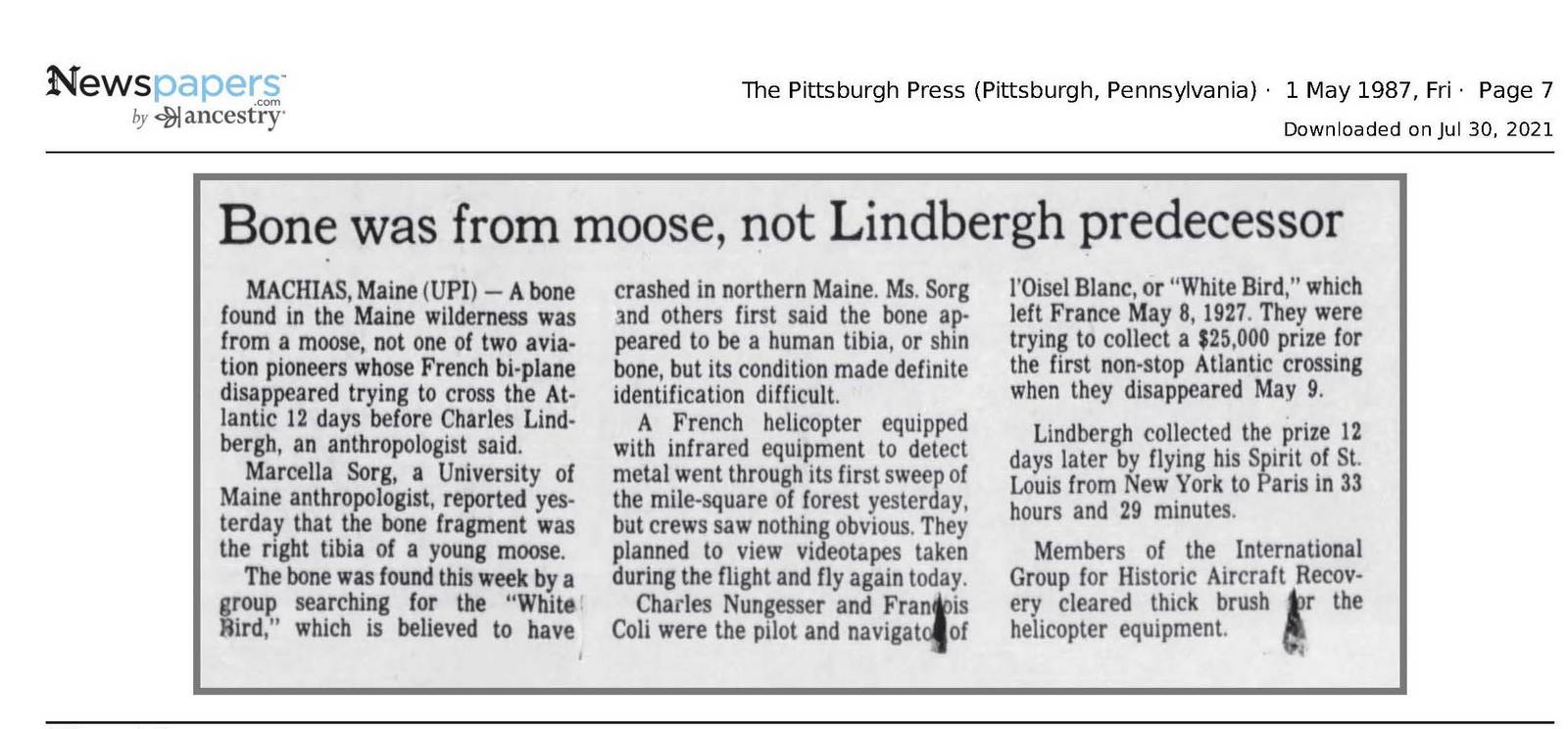
Again, nothing was found except some bones which when analyzed were from a moose.
After 19 expeditions to Maine TIGHAR concluded the plane had crashed in Newfoundland and gave up its search to find Amelia Earhart’s plane. Other groups have also searched for the plane including one led by the author Clive Cussler who in 1998 told the Bangor Daily he had spent 10 years searching for the plane with advanced sonar equipment in the lakes around Machias. Cussler was of the opinion the plane definitely made it to Maine and cites as evidence the numerous sightings of the plane along the coast which form a direct line to Washington County. Gillespie says there were 16 such sightings.
In fact 1927 newspaper articles report no actual sightings as the fog was too thick along the coast to see a plane. The reports of several Harbor Grace Newfoundlanders that they heard a plane were unverified and the witnesses admitted later that they couldn’t be sure they had heard a plane.If they had however Round Lake is on direct line between Harbor Grace and New York, the destination of the plane and the timing of the two alleged sightings is nearly perfect given the speed at which the plane should have been traveling.
On the negative side of the ledger is the conclusion of Sylvia Wrigley whose extensively researched May 21, 2021 article has this to say about the Round Lake theory:
“Now based on the timing, this could have been the same plane which overflew Harbor Grace. The sighting has even led to the theory that Maine bootleggers shot down the biplane, fearing police surveillance.
But even if that were likely, which it isn’t, then it means that L’Oiseau Blanc was still flying towards New York City, despite the fact that both pilots must have known that they could not possibly make it there. This makes no sense: Nungesser and Coli were highly competent pilots and by that time had already exceeded their planned flight of 40 hours. No magic wand could possibly have gotten them to New York to win the prize. They could not magic up fuel. It seems fantastical that they would simply carry on, knowing for a fact they did not have enough fuel to make their destination.” Before anyone heads to Round Lake to search for the White Bird we recommend you read Sylvia Wrigley’s complete article titled “ Fear of Landing, The Last Known Whereabouts of the White Bird.” We found it on the internet. It is extensively researched, well written and a very interesting account of not only the loss of the White Bird but the history of the competition to be the first to fly across the Atlantic.

